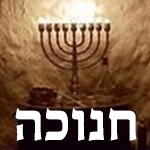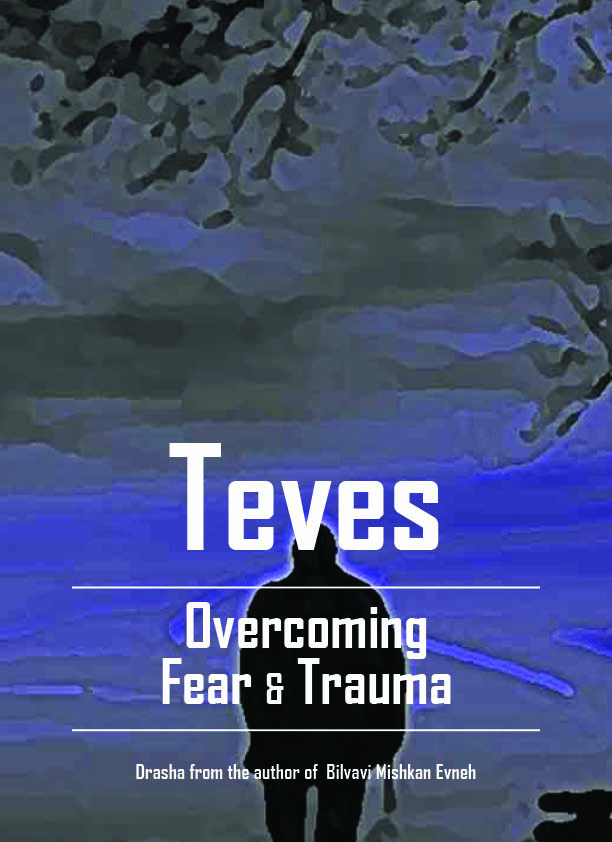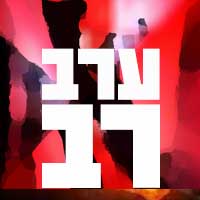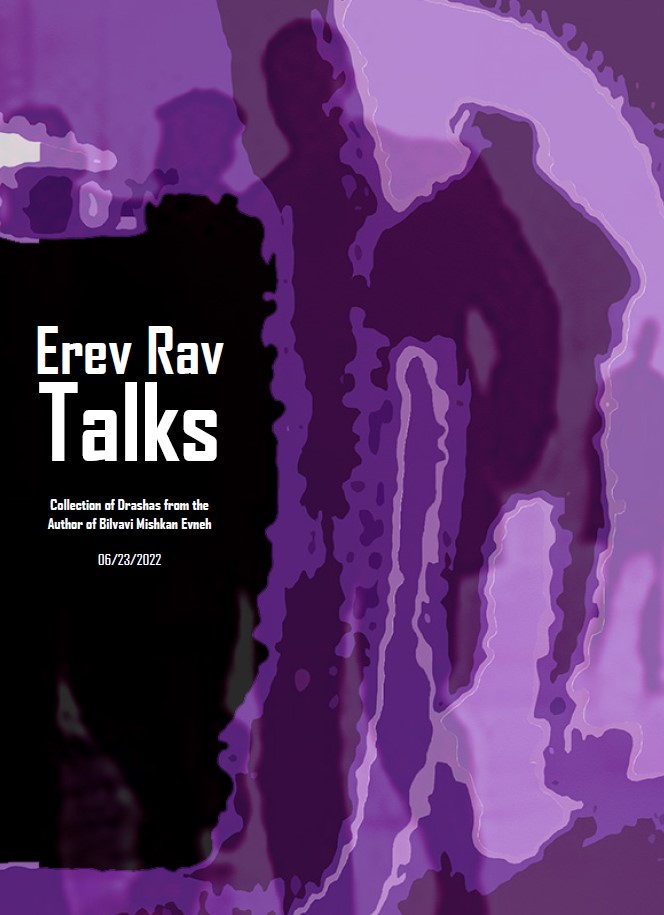- להאזנה דע את דעתך 008 ד מהלכים בתיקון המדמה
08 Rectifying Evil Imagination
- להאזנה דע את דעתך 008 ד מהלכים בתיקון המדמה
Utilizing Your Da'as - 08 Rectifying Evil Imagination
- 6841 reads
- Printer-friendly version
- שלח דף במייל
Good Da’as Is True Reality, and Evil Da’as Is Imagination
Previously, we spoke about how daas “turns over” information. We will continue to discuss this, daas hamis-hapeches.
As we explained, there is “daas tov” – thegood kind of daas, which was the daas of the Eitz HaChaim (Tree of Life), to know reality. “Daas ra”, the evil kind of daas, was the daas that entered us after Adam ate from the Eitz HaDaas (Tree of Knowledge), and it is essentially the imagination.
Both daas tov and daas ra have the common power to “turn over” something – daas tov can do this for a good cause, and daas ra does this for an evil outcome.
These two opposing kinds of daas are complete opposites, and they represent how everything in Creation consists of two parts – the concept of each thing, as well as the opposite of that very concept. The opposing perspectives of daas tov and daas ra are the root of the concept of how everything is made up of both itself and its opposite.
So daas tov is really havayah\reality, and daas ra is the medameh\imagination. These two concepts, daas tov and daas ra, are the root of all opposing concepts.
Medameh\imagination, is called “daas ra”, evil daas. When a person imagines something that isn’t true, what is he really doing? He’s using his daas to turn over reality and come up with the opposite of reality.
This is also called “sod hafachim”, the “secret of opposites”, that on one hand, we have our daas tov, which is reality as it is, and on the other hand, we have a falsified reality that gets created through our “daas ra”.
“Oid” (More) vs. “Ad” (Until)
Now that we have explained the outline of the concept, we can reflect into the following.
The word daas contains the letters daled and ayin, which can either form the word da, to “know,” and it can also mean ad, “until.” The letters daled and ayin can also form the opposite of ad, which reads oid, “more.” In other words, the opposite of good daas is when a person wants “more”. We will explain this.
Ad (“until”)says: there are limits. Oid (“more”) says: there is always more. They are both rooted on the same concept, however, as we will see.
The entire concept of medameh (imagination) is based on oid, “more.” The imagination says that “more” can be added on to reality - that if something is not here in reality, we can add it on to reality.
Medameh (imagination) is associated with Yosef Hatzaddik, of whom it is written “Oid Yosef chai”, “Yosef is still alive.” The word “oid”, “more”, is alluding to the imagination, because the imagination is “more” onto reality. Yosef had dreams, and he could interpret dreams, and dreams are a form of medameh. Medameh is therefore also called “hosafah”, adding, from the word “Yosef”. There are good and evil kinds of “adding”, and the evil kind of hosafah\adding is medameh.
Thus, medameh is all based on wanting to add – with imagination, a person seeks to add onto things that don’t exist. Yosef, who represents the power of medameh\ hosafah, is also called tzaddik yesod olam, (the righteous foundation of the world), which refers to holadah (procreation), for he was faced with a test to his kedushah (holiness) with being tempted by Potiphar’s wife. In the body, hosafah\holadah is with the mitzvah of child-bearing. This is the trait of Yosef, who represents yesod, the foundation, the power to guard one’s personal holiness and thus sanctify the ability of procreation.
The power to add is used for holiness when it is used for the mitzvah of childbearing, which does not merely add onto reality, but it continues reality, for it is a continuation. However, the evil side to this power is medameh, imagination, which is a deeply rooted evil desire to become like Hashem and know of good and evil, to be “a Creator of worlds”, a power to add. The Snake convinced Adam and Chavah through the power of medameh, but it was all based on hosafah\oid, telling them that there is “more”.
When is hosafah good, and when it is evil? It is good when it is used for childrearing, which starts from a droplet in the brain, and it is evil when it creates a new reality. So medameh is nursed from the power of hosafah in the soul, and this shows us how to rectify it, which we began to mention earlier.
“Ad” and “oid”, while being opposite concepts, have the same root. Medameh is based on oid\hosafah, thus, the way to repair medameh is by revealing “ad” within “oid”, which limits the power of “oid” in the soul from expanding. With medameh, a person is involved with the mode of oid in his soul. He has to come out of the mode of “oid” and enter into the mode of “ad”.
(We find that when a person is imagining, and suddenly he gets scared of something, his imagination stops. Why? It’s not because he has taken his mind off his fantasies. It is because he has entered into the mode of “ad” in the soul, by getting in touch with reality, which is essentially the concept of yirah\awe, to realize the limits of reality.)
Medameh causes a person to desire to break boundaries. The way to rectify this evil is through entering the mode of “ad” in the soul - to place limits. Medameh can only be active if you’re in the mode of oid in the soul, thus, the solution is to leave the viewpoint from oid and enter into the viewpoint of ad.
A Deeper Awareness
To say this in deeper terms: if you have become more clear about your soul, you are familiar with expanding and contracting the soul, and you can realize that imagination essentially makes you contract into yourself, thus, if you catch yourself imagining\ contracting, the imagination ceases.
However, this can only help someone who has clarified his soul abilities and he is consciously aware of his expansions and contractions of the soul. If he’s not yet this clear, he should just use the first, simpler solution, which is to focus on the limits of a reality. When he catches himself imagining, he should think about his surroundings, realize he is limited to reality, and this will silence his imagination, because it gives focus to the soul. Therefore, if someone has a tendency to imagine, when he catches himself imagining he should think about limits, and that will weaken his imagination.
Thus, medameh is based on the viewpoint of oid (“more”) in the soul and the way to leave it is to enter into the viewpoint of ad in the soul, which places limits on you and thereby helps restrict you.
What kind of ad should you enter into? There are many kinds of ad, because there are many ways how you can see limits. But the point is to be focused in your thoughts and your vision on something that is ad, to think about the limits of something. Everything had ad in it, because Hashem is in everything, and He has placed His limits in each thing He created.
To work on this concept, don’t look at something endless like the sky or the ocean, because that will only increase the imagination more. Only look at things that are limited and keep yourself focused on its boundaries and how it is limited.
This is how you rectify the oid\medameh in the soul: when you enter into ad. Soon we will explain how we leave evil oid and enter into a holy kind of oid, a concept that we mentioned earlier a little.
A Second Way To Rectify Imagination: Using The Holy Kind of “Oid”
As we have explained here, oid\medameh says that there is “more”, and that is why the mind desires to imagine. Medameh, as we explained earlier (in Chapter One), causes dilug (jumpiness) in the mind.
However, there is a holy way to use the power of oid: when the imagination is done with seder, orderliness. Unholy oid is when the medameh is happening through dilug, jumpiness, while holy oid is when the thought patterns of the imagination are taking place in an orderly fashion. For example, in a dream, there is no seder (orderliness), just dilug.
Medameh causes oid, a “new reality” created by the mind, and even more so, it has patterns of dilug, with no seder to it.
We don’t imagine something that doesn’t exist – we put together images in the mind, one image on top of the other, with no seder to it. Medameh takes images in the mind and combines then randomly. It is dilug. It is not yeish m’ayin, to create something from new; it is rather yeish m’yeish, to create something from something already existing.
Thus, another way to leave evil medameh is to enter the holy kind of medameh, which is to leave oid and enter ad, as we mentioned. (There are also higher ways to access holy imagination, and here we have only addressed the lowest use of it).
In this way, a person leaves the evil expansion mode and enters into a good kind of expansion, otherwise known as oid d’kedushah - to have seder (orderliness) in his imagination. Therefore, when a person catches himself imagining, he should get involved with seder, and that will sanctify his imagination.
To work on this practically, when you catch yourself imagining, try counting 1, 2, 3, 4, and so forth, and this trains you to get used to seder within your medameh. You can take a paper and write down numbers in order, or you can count the sefarim on the shelf. This weakens the evil imagination, because evil imagination thrives on dilug, as we explained.
When you enter into seder, you weaken dilug of the mind. To give a simple example of this concept, we can see that a person with seder in his life has much less medameh going on. His mind is less jumpy, because he is used to more orderliness in his life, so there isn’t much room for the imagination to take hold on him.
So far, we have explained two ways of how to leave evil medameh: through entering into the viewpoint of ad in the soul (accessed by focusing on the limits of something), and through oid d’kedushah, by giving order to your thoughts, via the act of counting in an orderly manner.
A Third Method of Rectifying Imagination: Using The Power of ‘Hosafah’
A third way to leave evil medameh is, through the power of “hosafah” that we mentioned. There are good and evil ways of how to use thus power. “Hosafah” is evil when it is used for evil imagination, and it is holy as follows.
Reality, which is called havayah, is really endless. What is the difference between havayah, which is endless (also called the Ein Sof\Endlessness) and medameh\imagination, which is also endless? The Ein Sof is “to hold onto a little of achdus and then you have everything,” as the Baal Shem Tov said. In other words, the entire Ein Sof is all contained in one point. But oid, or medameh\imagination, says that reality keeps expanding - not that everything is here in this point. So the Ein Sof is one havayah that contains everything.
To illustrate, a chair is not a table, whereas the havayah of the Ein Sof is one point that contains everything in it. But medameh is another kind of havayah, a havayah that keeps expanding – oid, oid, oid, more, more and more.
The root of medameh, as we explained, is rooted in the idea of “oid”. But there is a more inner root of medameh: that it creates “hipuch” - it turns over realities. “Hipuch” doesn’t mean you turn something into a new thing; it means to give a new face (panim chadashos) to something.
Everything in Creation has all the “faces” of reality in it, because there is only one havayah in Creation, and it is just that havayah has many facets to it. We see a “world of disparity” in front of us (alma d’piruda), in that we see many faces of reality, but there is still only one havayah\reality.
This is the depth behind the concept of daas hamis-hapeches (which we began to discuss in the previous chapter), which is the power of imagination: it turns over havayah and gives it other “faces”.
If someone understands this well, he knows the secret of all creations – that there is only one havayah (Hashem), and there are just many faces to the same havayah.
Thus, imagination thinks of new realities, because it’s really all ‘faces’ of the same reality. If we look at imagination in this way, we can use imagination for holiness and thus rectify the evil of the imagination.
These are subtle matters.
Rectifying Imagination Through Using “Havayah” (Comparing Imagination To Reality)
The depth of medameh is that there is only one havayah and that it can have many faces to it, therefore, I can be medameh (fantasize) it. The secret of all of creation is that it is all one havayah. The word oid simply means oid, more, but it can also mean gam, “also” – another side to the same reality.
So the root of medameh is not just coming from the mode of oid in the soul; that’s already the second step. The first root of medameh is from the one havayah that binds everything together, which enables medameh.
When this concept is used for holiness, it is “adameh l’Elyon”, to resemble the Creator. When it is used for evil, it is to create new realities – panim chadashos, “new faces”, which is the power of evil medameh\imagination.
This is also the root behind the concept of kefirah (heresy). Heresy is to deny havayah. So holy medameh is to realize that havayah includes everything, and evil medameh is to come up with new realities. Medameh denies the first havayah and comes up with a new havayah.
Therefore, “good” medameh doesn’t come up with something new. It is not simply to channel the evil kind of imagination for holiness. It is a whole different kind of imagination; it means to imagine that Hashem exists, to imagine that there is a Beis HaMikdash – to imagine something that already exists. We don’t see a Beis HaMikdash revealed, but we can connect to it in our imagination, because the Beis HaMikdash still exists in the inner realms that we don’t see.
Based on this understanding, evil medameh is to imagine something that does not exist. If someone merely channels the evil kind of imagination towards a holy purpose, this is not the true meaning of holy imagination, because as we have explained, evil and holy imagination are two totally different concepts of imagination.
Thus, to leave evil medameh, one can imagine the reality itself, and that destroys his imagined reality. For example, when Yosef was tempted, he imagined the image of his father. He didn’t just create a new image. When he saw his father’s image, his entire imagination fell.
This is a subtle matter. The idea is to compare the first imaginative thought with the second imaginative thought, realizing what the reality is, and this realization will cause the first imaginative thought to cease.
In Summary
Thus, daas hamis-hapeches can be used on a deeper level to turn medmaeh into havayah.
How do we leave medameh? The three ways we mentioned were: through the power of “ad”, through the power of “oid d’kedushah”, and through the power of havayah.
The third solution (havayah) is essentially to recognize how to use holy medameh:to understand that even medameh is really part of havayah. Holy medameh is really the p’nim (essence) of the havayah. Medameh is to give new panim\face to something, and havayah is the pnim of reality.
Thus, from a deeper understand, it is not that “daas tov” is havayah and that “daas ra” is medameh. According to this approach, havayah and medameh are not opposite viewpoints; rather, medameh is seen as part of havayah; the imagination is returned to reality.
If we understand this, we can proceed to the next point.
Opposites Bear The Same Root
There is a rule that all opposites bear the same root. As the Maharal writes, the words geulah (redemption) and galus (exile) bear the same root: “gal”, to reveal – because both the redemption and the exile are forms of revelation. They are just different forms of revelation. Why, indeed, do opposites share the same root? [We will explain as we go along].
With medameh, I can imagine something that does not exist. But to say it deeper, all havayah contains everything, because medameh is also part of havayah. It seems that medameh begins where havayah ends. But the root of medameh is that it is part of the havayah.
For example, there are the opposites of Yaakov and Esav, and there is the opposites of Adam (whom Yaakov is compared to) and there is Edom (another term for Esav). When Yaakov and Esav got older, their differences became apparent, but at first, they were one havayah. Therefore, at their root, Yaakov and Esav are called “brothers”. Thus, all of havayah includes itsopposite – which is its medameh.
Evil medameh is also called “achor” (the view from the back), and holy medameh is when it is revealed that achor is only a “pnim” (inside). The view of achor is related to the word “acher”, other, because when one has a view only from the back, he sees another person as “another”. The view from the panim (the front)says that the person you see is Reuven, while seeing the back of Reuven’s head tells you that it’s just someone else, because you can’t recognize him from the back.
But if we use the view of achor to reveal panim, then one can reveal the panim of Reuven even when I see his back. This is called the “sod h’achdus”, the secret of oneness, that can be reached through medameh.
Thus, the root of all opposites is always one root. All of havayah, including the imagined reality of medameh, is always part of the root. Everything has something it looks like – a table looks like another table, and that is a partial level of medameh. The general level of medameh is that mankind is either “adam” (ideal state of man)or “edom” (evil state of man, in which man follows his fantasies). But they are all rooted in one havayah.
In the future this will be revealed to all, so we cannot use this point practically in our times. But this concept, that havayah includes everything, is the deepest advice to overcome evil medameh.
Returning Medameh To “Havayah”
To practically access this deep power, look at everything as being rooted in one havayah. In everything you see, think about its opposite, and them think how it is rooted in one havayah, and this will uproot your evil medameh.
When the view from “achor” is turned into “panim”, when you see everything as being two sides of the same coin, this uproots the medameh; this because medameh is all about another reality, and when you view medameh as part of the havayah, the problem is solved at its root.
So the entire power of medameh gets its strength from “dovor v’hipucho”, seeing something and its opposite; when you see the connection between the two opposite concepts in a dovor v’hipucho, there is no place for medameh; it is when you see the panim and achor of something as being two sides of the same coin.
In the future, we will realize that “we were like dreamers”[1] - we will realize that “achor”\medameh is really just another “panim” (facet) of havayah. This will completely remove medameh.
To practically work on this, look at each thing and see what its opposite is, and then remind yourself that they are rooted in one root, for there are always two sides of the same coin.
This concept, seeing “dovor v’hipucho” (something and its oppsite)and thereby returning each thing to its havayah, is the deepest way to fix evil medameh.
NOTE: Final english versions are only found in the Rav's printed seforim »













